流程梳理核心组件
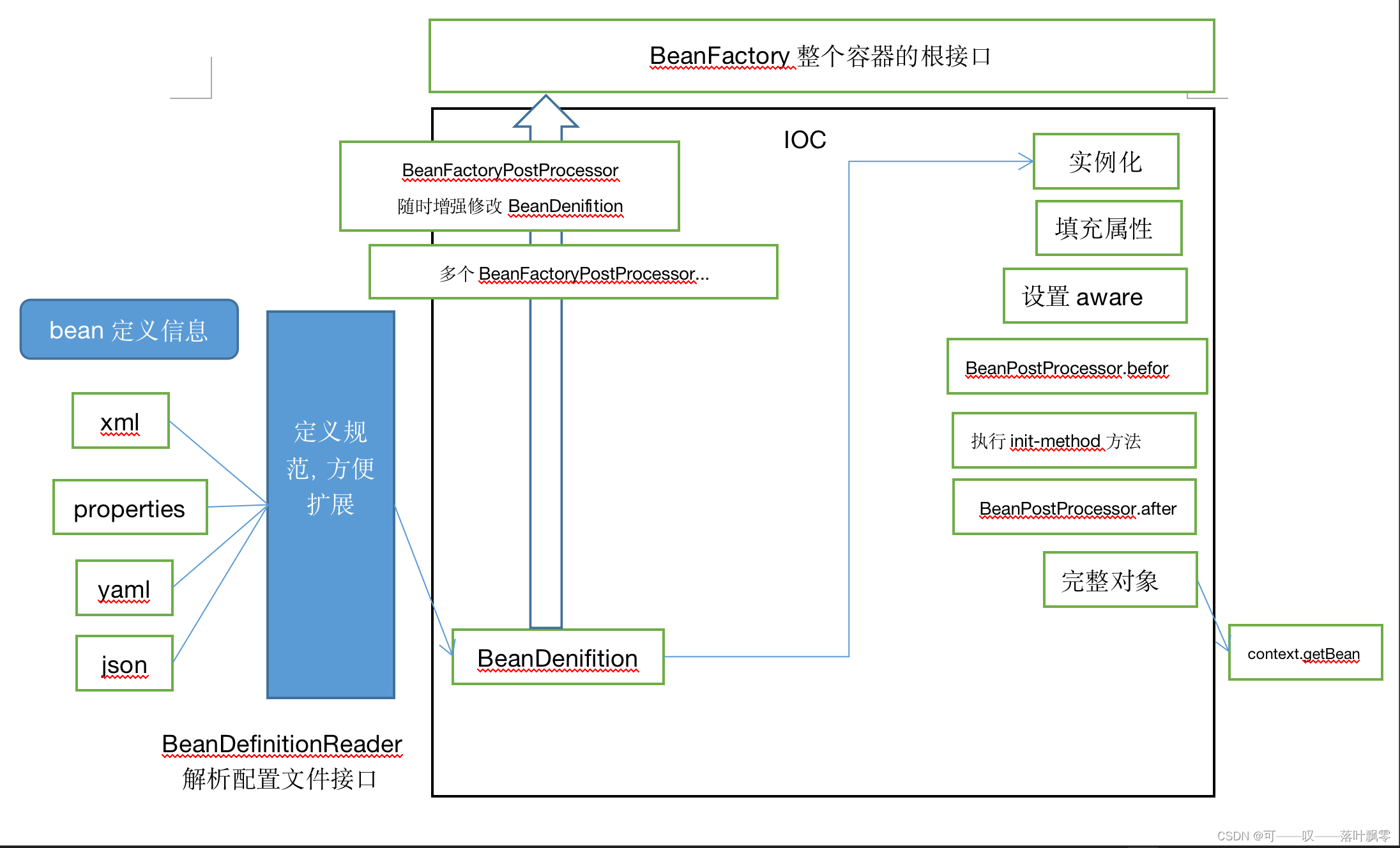
BeanDefinitionReader
用来读取解析文件生成BeanDefinition的接口,除了xml文件可自定义各种规范如json文件解析成BeanDefinition
BeanDefinition
BeanDefinition是一个接口,它定义了一个bean的描述。一个BeanDefinition包含一个bean的名称、属性和构造函数的参数值等信息。
具体实现BeanDefinition接口的类还可以提供更多的信息,例如bean的类型、作用域、初始化方法等
BeanFactoryPostProcessor
增强修改BeanDenifition,(比如xml里的${jdbc.url}等占位符值的替换)
BeanPostProcessor
增强bean信息
Aware
对创建的bean进行操作的时候,如果需要其他对象,可以实现aware接口满足需要
Environment
访问和检索配置信息,将配置信息存储在各种属性源中,例如属性文件、环境变量、命令行参数等
StandardEnvironment->(System.getenv()和System.getProperties())
例子
application.properties
a.b=good
@Autowired
private Environment environment;
//使用
String property = environment.getProperty("a.b");
System.out.println(property);
FactoryBean
接口三个方法
getObject();
Class<?> getObjectType();
boolean isSingleton();
BeanFactory生成bean要遵循spring完整的创建过程,由 spring 管理
FactoryBean是自己定义的创建bean的方式,只需要通过getObject方法即可
启动核心方法refresh方法
@Override
public void refresh() throws BeansException, IllegalStateException {
synchronized (this.startupShutdownMonitor) {
// Prepare this context for refreshing.
/**
* 做刷新容器前的准备
* 1.设置容器启动时间
* 2.设置活跃状态true,关闭状态false
* 3.获取Environment对象并加载当前系统的系统属性值到Environment对象中
* 4.准备监听器和事件的对象,默认为空的集合
*/
prepareRefresh();
// Tell the subclass to refresh the internal bean factory.
/**
* 创建容器对象DefaultListableBeanFactory
* 加载xml配置文件的属性到当前工厂中,最重要的就是BeanDenifition
*/
ConfigurableListableBeanFactory beanFactory = obtainFreshBeanFactory();
// Prepare the bean factory for use in this context.
/**
* beanFactory准备工作,填充各种属性
*/
prepareBeanFactory(beanFactory);
try {
// Allows post-processing of the bean factory in context subclasses.
/**
* 空方法,子类覆盖方法做额外处理,此处一般不做任何扩展操作,可以看web中的代码是有实现的
*/
postProcessBeanFactory(beanFactory);
// Invoke factory processors registered as beans in the context.
/**
* 调用执行各种BeanFactoryPostProcessor,里面会调用beanFactory.getBean()找到自定义beanFactoryPostProcessor
* BeanFactoryPostProcessor接口的postProcessBeanFactory方法
* BeanFactoryPostProcessor增强修改BeanDenifition
* springboot自动装配@import使用子类ConfigruationClassPostProcessor
*/
invokeBeanFactoryPostProcessors(beanFactory);
/**
* 注册BeanPostProcessor
* 里面会调用beanFactory.getBean()找到自定义beanPostProcessor
*/
// Register bean processors that intercept bean creation.
registerBeanPostProcessors(beanFactory);
/**
* 初始化信息源,和国际化相关.
* 调用beanFactory.registerSingleton()注册完整的messageSource对象到一级缓存
*/
// Initialize message source for this context.
initMessageSource();
/**
* 初始化容器事件传播器.
* beanFactory.registerSingleton()注册进去applicationEventMulticaster
*/
// Initialize event multicaster for this context.
initApplicationEventMulticaster();
// Initialize other special beans in specific context subclasses.
/**
* 空方法
*/
onRefresh();
/**
* 为事件传播器注册事件监听器.
* 这个和上两个方法与ioc没关系
*/
// Check for listener beans and register them.
registerListeners();
// Instantiate all remaining (non-lazy-init) singletons.
/**
* 初始化剩下的单实例(非懒加载的)
*/
finishBeanFactoryInitialization(beanFactory);
/**
* 初始化容器的生命周期事件处理器,并发布容器的生命周期事件
*/
// Last step: publish corresponding event.
finishRefresh();
}
catch (BeansException ex) {
if (logger.isWarnEnabled()) {
logger.warn("Exception encountered during context initialization - " +
"cancelling refresh attempt: " + ex);
}
// Destroy already created singletons to avoid dangling resources.
destroyBeans();
// Reset 'active' flag.
cancelRefresh(ex);
// Propagate exception to caller.
throw ex;
}
finally {
// Reset common introspection caches in Spring's core, since we
// might not ever need metadata for singleton beans anymore...
resetCommonCaches();
}
}
}
解析
创建 bean的过程
通过 refresh方法的
// Instantiate all remaining (non-lazy-init) singletons.
/**
* 初始化剩下的单实例(非懒加载的)
*/
finishBeanFactoryInitialization(beanFactory);
执行创建剩下的单实例
可以看做调用链条
getBean()->doGetBean()->createBean()->doCreateBean()->createBeanInstance()->populateBean()
getBean:是BeanFactory的方法
doGetBean:实际干活的方法
createBean:创建bean
doCreateBean:实际干活的方法
createBeanInstance:反射实例化创建bean
populateBean:对实例属性赋值,循环依赖走这里循环调用到getBean方法
实例化bean后的流程
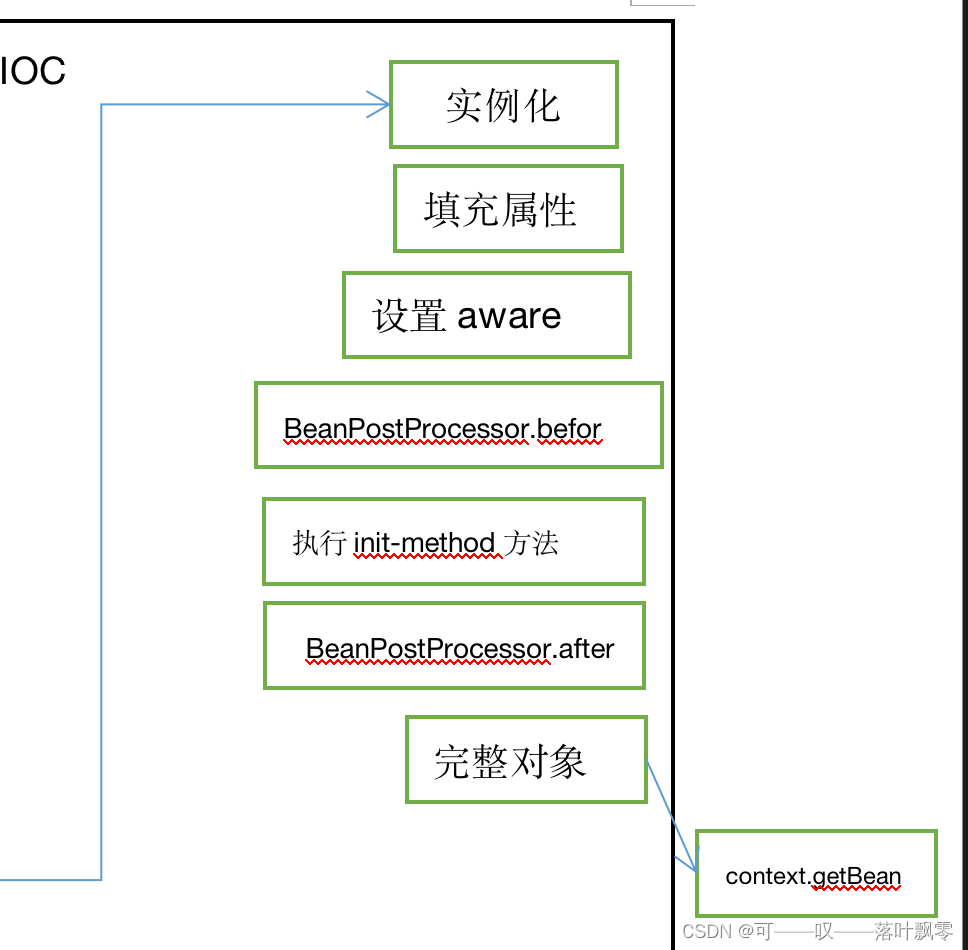
1.createBeanInstance实例化,开辟堆内存空间
2.属性赋值populateBean
3.判断是否实现了Aware接口,容器对象属性设置invokeAwareMethods(到这里实际上对象初始化完成了,下面流程进行增强)
4.调用beanPostProcessor的前置before方法
5.调用初始化方法invokeInitMethods ->判断如果实现InitializingBean就执行afterPropertiesSet,否则直接执行initMethod即可
6.调用beanPostProcessor的后置after方法,创建代理aop对象是这里,
从earlyProxyReferences缓存判断key(getEarlyBeanReference方法放进去的)无循环依赖就走这里创建aop对象,不然走getEarlyBeanReference方法
7.完整对象
三级缓存
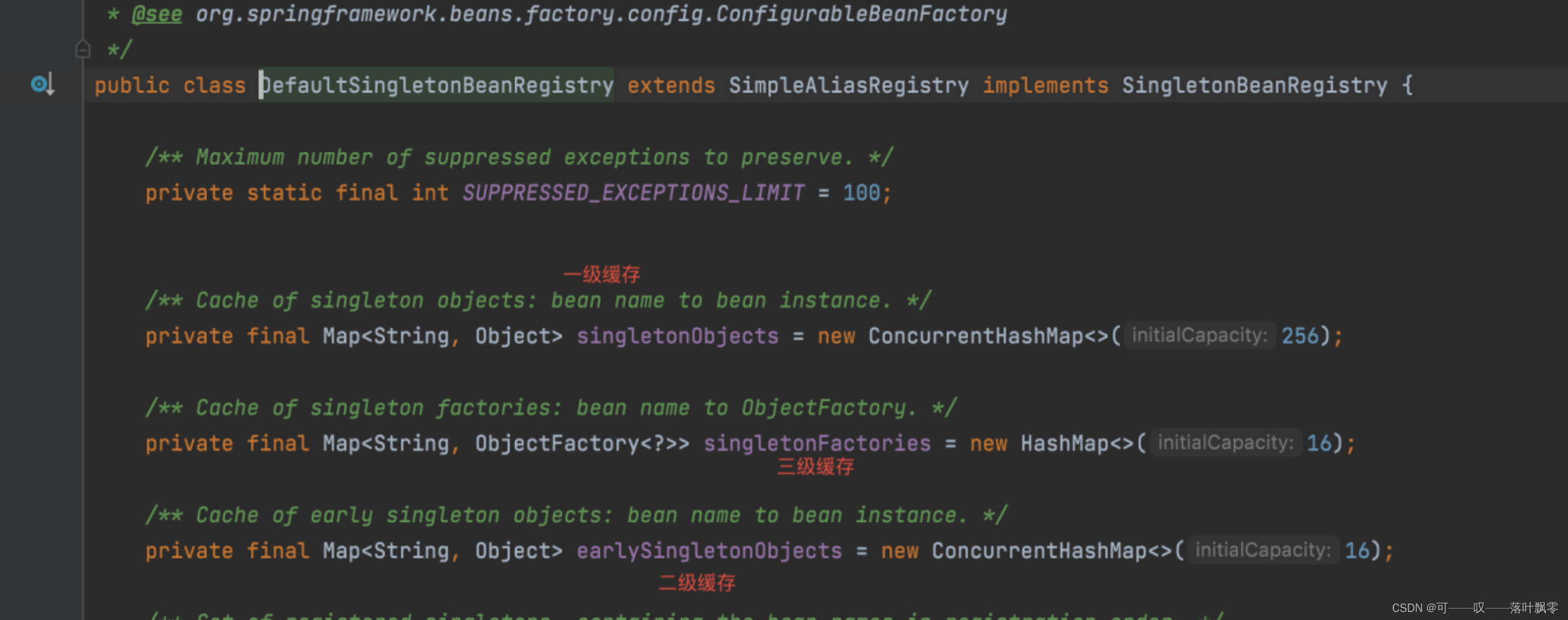
DefaultSingletonBeanRegistry
/** 1级缓存Cache of singleton objects: bean name to bean instance. */
private final Map<String, Object> singletonObjects = new ConcurrentHashMap<>(256);
/** 3级缓存Cache of singleton factories: bean name to ObjectFactory. */
private final Map<String, ObjectFactory<?>> singletonFactories = new HashMap<>(16);
/** 2级缓存Cache of early singleton objects: bean name to bean instance. */
private final Map<String, Object> earlySingletonObjects = new ConcurrentHashMap<>(16);
循环依赖
现有A,B两个类,A有属性b,B有属性a
从上面说的refresh方法开始执行到
/**
* 初始化剩下的单实例(非懒加载的)
*/
finishBeanFactoryInitialization(beanFactory);
->beanFactory.preInstantiateSingletons();
@Override
public void preInstantiateSingletons() throws BeansException {
if (logger.isTraceEnabled()) {
logger.trace("Pre-instantiating singletons in " + this);
}
// Iterate over a copy to allow for init methods which in turn register new bean definitions.
// While this may not be part of the regular factory bootstrap, it does otherwise work fine.
/**
* 将所有的beanDefinition名字创建一个集合
*/
List<String> beanNames = new ArrayList<>(this.beanDefinitionNames);
// Trigger initialization of all non-lazy singleton beans...
for (String beanName : beanNames) {
RootBeanDefinition bd = getMergedLocalBeanDefinition(beanName);
if (!bd.isAbstract() && bd.isSingleton() && !bd.isLazyInit()) {
/**
* 如果是自定义的factoryBean
*/
if (isFactoryBean(beanName)) {
Object bean = getBean(FACTORY_BEAN_PREFIX + beanName);
if (bean instanceof FactoryBean) {
FactoryBean<?> factory = (FactoryBean<?>) bean;
boolean isEagerInit;
if (System.getSecurityManager() != null && factory instanceof SmartFactoryBean) {
isEagerInit = AccessController.doPrivileged(
(PrivilegedAction<Boolean>) ((SmartFactoryBean<?>) factory)::isEagerInit,
getAccessControlContext());
}
else {
isEagerInit = (factory instanceof SmartFactoryBean &&
((SmartFactoryBean<?>) factory).isEagerInit());
}
if (isEagerInit) {
getBean(beanName);
}
}
}
else {
/**
* 第一步getBean,不是自己定义FactoryBean就走这里由spring完整规范创建bean
*/
getBean(beanName);
}
}
}
// Trigger post-initialization callback for all applicable beans...
for (String beanName : beanNames) {
Object singletonInstance = getSingleton(beanName);
if (singletonInstance instanceof SmartInitializingSingleton) {
SmartInitializingSingleton smartSingleton = (SmartInitializingSingleton) singletonInstance;
if (System.getSecurityManager() != null) {
AccessController.doPrivileged((PrivilegedAction<Object>) () -> {
smartSingleton.afterSingletonsInstantiated();
return null;
}, getAccessControlContext());
}
else {
smartSingleton.afterSingletonsInstantiated();
}
}
}
}
getBean(beanName);->
@Override
public Object getBean(String name) throws BeansException {
return doGetBean(name, null, null, false);
}
protected <T> T doGetBean(
String name, @Nullable Class<T> requiredType, @Nullable Object[] args, boolean typeCheckOnly)
throws BeansException {
String beanName = transformedBeanName(name);
Object bean;
// Eagerly check singleton cache for manually registered singletons.
/**
* 循环依赖的时候b创建好赋值a的时候,从这里拿到三级缓存的a
* 并把a放到二级缓存
*/
Object sharedInstance = getSingleton(beanName);
if (sharedInstance != null && args == null) {
if (logger.isTraceEnabled()) {
if (isSingletonCurrentlyInCreation(beanName)) {
logger.trace("Returning eagerly cached instance of singleton bean '" + beanName +
"' that is not fully initialized yet - a consequence of a circular reference");
}
else {
logger.trace("Returning cached instance of singleton bean '" + beanName + "'");
}
}
bean = getObjectForBeanInstance(sharedInstance, name, beanName, null);
}
else {
// Fail if we're already creating this bean instance:
// We're assumably within a circular reference.
if (isPrototypeCurrentlyInCreation(beanName)) {
throw new BeanCurrentlyInCreationException(beanName);
}
// Check if bean definition exists in this factory.
BeanFactory parentBeanFactory = getParentBeanFactory();
if (parentBeanFactory != null && !containsBeanDefinition(beanName)) {
// Not found -> check parent.
String nameToLookup = originalBeanName(name);
if (parentBeanFactory instanceof AbstractBeanFactory) {
return ((AbstractBeanFactory) parentBeanFactory).doGetBean(
nameToLookup, requiredType, args, typeCheckOnly);
}
else if (args != null) {
// Delegation to parent with explicit args.
return (T) parentBeanFactory.getBean(nameToLookup, args);
}
else if (requiredType != null) {
// No args -> delegate to standard getBean method.
return parentBeanFactory.getBean(nameToLookup, requiredType);
}
else {
return (T) parentBeanFactory.getBean(nameToLookup);
}
}
if (!typeCheckOnly) {
markBeanAsCreated(beanName);
}
try {
RootBeanDefinition mbd = getMergedLocalBeanDefinition(beanName);
checkMergedBeanDefinition(mbd, beanName, args);
// Guarantee initialization of beans that the current bean depends on.
String[] dependsOn = mbd.getDependsOn();
if (dependsOn != null) {
for (String dep : dependsOn) {
if (isDependent(beanName, dep)) {
throw new BeanCreationException(mbd.getResourceDescription(), beanName,
"Circular depends-on relationship between '" + beanName + "' and '" + dep + "'");
}
registerDependentBean(dep, beanName);
try {
getBean(dep);
}
catch (NoSuchBeanDefinitionException ex) {
throw new BeanCreationException(mbd.getResourceDescription(), beanName,
"'" + beanName + "' depends on missing bean '" + dep + "'", ex);
}
}
}
// Create bean instance.
if (mbd.isSingleton()) {
/**
* getSingleton最后调用addSingleton把b放到一级缓存
* 同理 a创建完成也是放到一级缓存
*/
sharedInstance = getSingleton(beanName, () -> {
try {
// 调用链条这里进去
return createBean(beanName, mbd, args);
}
catch (BeansException ex) {
// Explicitly remove instance from singleton cache: It might have been put there
// eagerly by the creation process, to allow for circular reference resolution.
// Also remove any beans that received a temporary reference to the bean.
destroySingleton(beanName);
throw ex;
}
});
bean = getObjectForBeanInstance(sharedInstance, name, beanName, mbd);
}
else if (mbd.isPrototype()) {
// It's a prototype -> create a new instance.
Object prototypeInstance = null;
try {
beforePrototypeCreation(beanName);
prototypeInstance = createBean(beanName, mbd, args);
}
finally {
afterPrototypeCreation(beanName);
}
bean = getObjectForBeanInstance(prototypeInstance, name, beanName, mbd);
}
else {
String scopeName = mbd.getScope();
if (!StringUtils.hasLength(scopeName)) {
throw new IllegalStateException("No scope name defined for bean ´" + beanName + "'");
}
Scope scope = this.scopes.get(scopeName);
if (scope == null) {
throw new IllegalStateException("No Scope registered for scope name '" + scopeName + "'");
}
try {
Object scopedInstance = scope.get(beanName, () -> {
beforePrototypeCreation(beanName);
try {
return createBean(beanName, mbd, args);
}
finally {
afterPrototypeCreation(beanName);
}
});
bean = getObjectForBeanInstance(scopedInstance, name, beanName, mbd);
}
catch (IllegalStateException ex) {
throw new BeanCreationException(beanName,
"Scope '" + scopeName + "' is not active for the current thread; consider " +
"defining a scoped proxy for this bean if you intend to refer to it from a singleton",
ex);
}
}
}
catch (BeansException ex) {
cleanupAfterBeanCreationFailure(beanName);
throw ex;
}
}
// Check if required type matches the type of the actual bean instance.
if (requiredType != null && !requiredType.isInstance(bean)) {
try {
T convertedBean = getTypeConverter().convertIfNecessary(bean, requiredType);
if (convertedBean == null) {
throw new BeanNotOfRequiredTypeException(name, requiredType, bean.getClass());
}
return convertedBean;
}
catch (TypeMismatchException ex) {
if (logger.isTraceEnabled()) {
logger.trace("Failed to convert bean '" + name + "' to required type '" +
ClassUtils.getQualifiedName(requiredType) + "'", ex);
}
throw new BeanNotOfRequiredTypeException(name, requiredType, bean.getClass());
}
}
return (T) bean;
}
createBean(beanName, mbd, args)->Object beanInstance = doCreateBean(beanName, mbdToUse, args);
protected Object doCreateBean(String beanName, RootBeanDefinition mbd, @Nullable Object[] args)
throws BeanCreationException {
// Instantiate the bean.
BeanWrapper instanceWrapper = null;
if (mbd.isSingleton()) {
instanceWrapper = this.factoryBeanInstanceCache.remove(beanName);
}
if (instanceWrapper == null) {
/**
* 步骤createBeanInstance,反射实例化
*/
instanceWrapper = createBeanInstance(beanName, mbd, args);
}
Object bean = instanceWrapper.getWrappedInstance();
Class<?> beanType = instanceWrapper.getWrappedClass();
if (beanType != NullBean.class) {
mbd.resolvedTargetType = beanType;
}
// Allow post-processors to modify the merged bean definition.
synchronized (mbd.postProcessingLock) {
if (!mbd.postProcessed) {
try {
/**
* auowried自动注入,从这里进去,拿到需要注入的信息
*/
applyMergedBeanDefinitionPostProcessors(mbd, beanType, beanName);
}
catch (Throwable ex) {
throw new BeanCreationException(mbd.getResourceDescription(), beanName,
"Post-processing of merged bean definition failed", ex);
}
mbd.postProcessed = true;
}
}
// Eagerly cache singletons to be able to resolve circular references
// even when triggered by lifecycle interfaces like BeanFactoryAware.
boolean earlySingletonExposure = (mbd.isSingleton() && this.allowCircularReferences &&
isSingletonCurrentlyInCreation(beanName));
if (earlySingletonExposure) {
if (logger.isTraceEnabled()) {
logger.trace("Eagerly caching bean '" + beanName +
"' to allow for resolving potential circular references");
}
/**
* 加入三级缓存
* getEarlyBeanReference判断是要暴露原始对象还是代理对象,需要代理返回代理,没有就原始
* invokeAwareMethods如果实现aware就执行aware的接口方法
* AOP是这个方法里用到的beanPostProcessor的扩展实现
*/
addSingletonFactory(beanName, () -> getEarlyBeanReference(beanName, mbd, bean));
}
// Initialize the bean instance.
Object exposedObject = bean;
try {
/**
* 步骤populateBean,填充属性
* autowired注入
*/
populateBean(beanName, mbd, instanceWrapper);
/**
* initializeBean里面执行BeanPostProcessor的 before,after
*/
exposedObject = initializeBean(beanName, exposedObject, mbd);
}
catch (Throwable ex) {
if (ex instanceof BeanCreationException && beanName.equals(((BeanCreationException) ex).getBeanName())) {
throw (BeanCreationException) ex;
}
else {
throw new BeanCreationException(
mbd.getResourceDescription(), beanName, "Initialization of bean failed", ex);
}
}
if (earlySingletonExposure) {
Object earlySingletonReference = getSingleton(beanName, false);
if (earlySingletonReference != null) {
if (exposedObject == bean) {
exposedObject = earlySingletonReference;
}
else if (!this.allowRawInjectionDespiteWrapping && hasDependentBean(beanName)) {
String[] dependentBeans = getDependentBeans(beanName);
Set<String> actualDependentBeans = new LinkedHashSet<>(dependentBeans.length);
for (String dependentBean : dependentBeans) {
if (!removeSingletonIfCreatedForTypeCheckOnly(dependentBean)) {
actualDependentBeans.add(dependentBean);
}
}
if (!actualDependentBeans.isEmpty()) {
throw new BeanCurrentlyInCreationException(beanName,
"Bean with name '" + beanName + "' has been injected into other beans [" +
StringUtils.collectionToCommaDelimitedString(actualDependentBeans) +
"] in its raw version as part of a circular reference, but has eventually been " +
"wrapped. This means that said other beans do not use the final version of the " +
"bean. This is often the result of over-eager type matching - consider using " +
"'getBeanNamesForType' with the 'allowEagerInit' flag turned off, for example.");
}
}
}
}
// Register bean as disposable.
try {
registerDisposableBeanIfNecessary(beanName, bean, mbd);
}
catch (BeanDefinitionValidationException ex) {
throw new BeanCreationException(
mbd.getResourceDescription(), beanName, "Invalid destruction signature", ex);
}
return exposedObject;
}
populateBean方法赋值属性如果存在其他bean引用会调用到getBean()方法从头开始循环
上面的流程走完的路程是
先创建 A ->a创建好就放到三级缓存(删除二级缓存的a,反正也没有)-> 再给 A属性赋值,发现b是空 -> 就去创建 b,创建好把b放三级缓存
-> 再给b属性赋值(getSigleton方法),先从一级缓存拿a,空就从二级缓存拿 a,空就从三级拿a,拿到之后,把 a放到二级缓存,删除三级缓存的a
-> b完成创建成品 -> addSigleton方法把b放到一级缓存,并清空二三级的b -> a赋值完 b后面成为成品也执行addSigleton
这里的三级缓存是Map<String, ObjectFactory<?>>,存放的是ObjectFactory接口的lambda表达式getEarlyBeanReference,当循环依赖的时候存在AOP代理对象,就会执行到getEarlyBeanReference
/**
* 加入三级缓存
* getEarlyBeanReference判断是要暴露原始对象还是代理对象,需要代理返回代理,没有就原始,里面有个缓存this.earlyProxyReferences.put(cacheKey, bean);)
* invokeAwareMethods如果实现aware就执行aware的接口方法
* AOP是这个方法里用到的beanPostProcessor的扩展实现
*/
addSingletonFactory(beanName, () -> getEarlyBeanReference(beanName, mbd, bean));
AOP原理
aop是ioc的扩展实现,实现BeanPostProcessor接口调用after方法创建代理对象
BeanPostProcessor->AOP->动态代理(JDK/CGLIB)
public abstract class AbstractAutoProxyCreator extends ProxyProcessorSupport
implements SmartInstantiationAwareBeanPostProcessor, BeanFactoryAware {
AbstractAutoProxyCreator实现了BeanPostProcessor
spring创建 AOP代理对象的地方有两个
1.在BeanPostProcessor接口的after方法里会创建代理对象
/**
* 步骤populateBean,填充属性
* autowired注入
*/
populateBean(beanName, mbd, instanceWrapper);
/**
* initializeBean里面执行BeanPostProcessor的 before,after
* 在这里执行after方法由AbstractAutoProxyCreator创建代理对象
*/
exposedObject = initializeBean(beanName, exposedObject, mbd);
createBeanInstance方法之后,会把实例化的对象放入三级缓存,当存在循环依赖的AOP代理对象的时候,在getSingleton方法会执行到getEarlyBeanReference提前创建代理对象,并放进缓存,防止在initializeBean里面调用AbstractAutoProxyCreator的after方法重复创建,
这里依然是循环调用BeanPostProcessor
/**
* 加入三级缓存
* getEarlyBeanReference判断是要暴露原始对象还是代理对象,需要代理返回代理,没有就原始
* invokeAwareMethods如果实现aware就执行aware的接口方法
* AOP是这个方法里用到的beanPostProcessor的扩展实现
*/
addSingletonFactory(beanName, () -> getEarlyBeanReference(beanName, mbd, bean));
------------------
protected Object getEarlyBeanReference(String beanName, RootBeanDefinition mbd, Object bean) {
System.out.println("开始执行getEarlyBeanReference()方法,beanName="+beanName);
Object exposedObject = bean;
if (!mbd.isSynthetic() && hasInstantiationAwareBeanPostProcessors()) {
/**
* AOP
* AbstractAutoProxyCreator是BeanPostProcessor的子类实现
* 可以看看子类的createProxy,CGLIB/JDK
*/
for (BeanPostProcessor bp : getBeanPostProcessors()) {
if (bp instanceof SmartInstantiationAwareBeanPostProcessor) {
SmartInstantiationAwareBeanPostProcessor ibp = (SmartInstantiationAwareBeanPostProcessor) bp;
exposedObject = ibp.getEarlyBeanReference(exposedObject, beanName);
}
}
}
return exposedObject;
}
@Autowired原理
通过AutowiredAnnotationBeanPostProcessor来实现
public class AutowiredAnnotationBeanPostProcessor extends InstantiationAwareBeanPostProcessorAdapter
implements MergedBeanDefinitionPostProcessor, PriorityOrdered, BeanFactoryAware {
AbstractAutowireCapableBeanFactory的doCreateBean会执行到
// Allow post-processors to modify the merged bean definition.
synchronized (mbd.postProcessingLock) {
if (!mbd.postProcessed) {
try {
/**
* auowried自动注入,从这里进去,拿到需要注入的信息
*/
applyMergedBeanDefinitionPostProcessors(mbd, beanType, beanName);
}
catch (Throwable ex) {
throw new BeanCreationException(mbd.getResourceDescription(), beanName,
"Post-processing of merged bean definition failed", ex);
}
mbd.postProcessed = true;
}
}
// Eagerly cache singletons to be able to resolve circular references
// even when triggered by lifecycle interfaces like BeanFactoryAware.
boolean earlySingletonExposure = (mbd.isSingleton() && this.allowCircularReferences &&
isSingletonCurrentlyInCreation(beanName));
if (earlySingletonExposure) {
if (logger.isTraceEnabled()) {
logger.trace("Eagerly caching bean '" + beanName +
"' to allow for resolving potential circular references");
}
addSingletonFactory(beanName, () -> getEarlyBeanReference(beanName, mbd, bean));
}
// Initialize the bean instance.
Object exposedObject = bean;
try {
/**
* 步骤populateBean,填充属性
* autowired注入
*/
populateBean(beanName, mbd, instanceWrapper);
exposedObject = initializeBean(beanName, exposedObject, mbd);
}
进入applyMergedBeanDefinitionPostProcessors方法
protected void applyMergedBeanDefinitionPostProcessors(RootBeanDefinition mbd, Class<?> beanType, String beanName) {
for (BeanPostProcessor bp : getBeanPostProcessors()) {
/**
* AutowiredAnnotationBeanPostProcessor实现了MergedBeanDefinitionPostProcessor接口,
* 进而实现了接口中的postProcessMergedBeanDefinition方法
*/
if (bp instanceof MergedBeanDefinitionPostProcessor) {
MergedBeanDefinitionPostProcessor bdp = (MergedBeanDefinitionPostProcessor) bp;
bdp.postProcessMergedBeanDefinition(mbd, beanType, beanName);
}
}
}
进入postProcessMergedBeanDefinition方法
@Override
public void postProcessMergedBeanDefinition(RootBeanDefinition beanDefinition, Class<?> beanType, String beanName) {
//获取有@Autowired注解的元数据
InjectionMetadata metadata = findAutowiringMetadata(beanName, beanType, null);
metadata.checkConfigMembers(beanDefinition);
}
最终checkedElements就是@Autowired注解的属性元素

然后在populateBean方法里
for (BeanPostProcessor bp : getBeanPostProcessors()) {
if (bp instanceof InstantiationAwareBeanPostProcessor) {
InstantiationAwareBeanPostProcessor ibp = (InstantiationAwareBeanPostProcessor) bp;
// 开始真正autowried注入
PropertyValues pvsToUse = ibp.postProcessProperties(pvs, bw.getWrappedInstance(), beanName);
if (pvsToUse == null) {
if (filteredPds == null) {
filteredPds = filterPropertyDescriptorsForDependencyCheck(bw, mbd.allowCaching);
}
pvsToUse = ibp.postProcessPropertyValues(pvs, filteredPds, bw.getWrappedInstance(), beanName);
if (pvsToUse == null) {
return;
}
}
pvs = pvsToUse;
}
}
进入postProcessProperties方法
@Override
public PropertyValues postProcessProperties(PropertyValues pvs, Object bean, String beanName) {
// 这里获取metadata是从缓存获取的
InjectionMetadata metadata = findAutowiringMetadata(beanName, bean.getClass(), pvs);
try {
/**
* 注入
*/
metadata.inject(bean, beanName, pvs);
}
catch (BeanCreationException ex) {
throw ex;
}
catch (Throwable ex) {
throw new BeanCreationException(beanName, "Injection of autowired dependencies failed", ex);
}
return pvs;
}
进入inject再进入element.inject(target, beanName, pvs);
是AutowiredAnnotationBeanPostProcessor实现的inject方法
真正赋值成功在这里
@Override
protected void inject(Object bean, @Nullable String beanName, @Nullable PropertyValues pvs) throws Throwable {
Field field = (Field) this.member;
Object value;
if (this.cached) {
value = resolvedCachedArgument(beanName, this.cachedFieldValue);
}
else {
DependencyDescriptor desc = new DependencyDescriptor(field, this.required);
desc.setContainingClass(bean.getClass());
Set<String> autowiredBeanNames = new LinkedHashSet<>(1);
Assert.state(beanFactory != null, "No BeanFactory available");
TypeConverter typeConverter = beanFactory.getTypeConverter();
try {
// 获取需要注入的bean实例
// value是最终调用到调用factory.getBean()方法得到需要注入的对象
// 依然可看作是循环依赖
value = beanFactory.resolveDependency(desc, beanName, autowiredBeanNames, typeConverter);
}
catch (BeansException ex) {
throw new UnsatisfiedDependencyException(null, beanName, new InjectionPoint(field), ex);
}
synchronized (this) {
if (!this.cached) {
if (value != null || this.required) {
this.cachedFieldValue = desc;
registerDependentBeans(beanName, autowiredBeanNames);
if (autowiredBeanNames.size() == 1) {
String autowiredBeanName = autowiredBeanNames.iterator().next();
if (beanFactory.containsBean(autowiredBeanName) &&
beanFactory.isTypeMatch(autowiredBeanName, field.getType())) {
this.cachedFieldValue = new ShortcutDependencyDescriptor(
desc, autowiredBeanName, field.getType());
}
}
}
else {
this.cachedFieldValue = null;
}
this.cached = true;
}
}
}
if (value != null) {
ReflectionUtils.makeAccessible(field);
// 真正注入@Autowired注解标注的属性值
field.set(bean, value);
}
}
}
@Resource原理
和@Autowired大致相同,入口地方相同
AbstractAutowireCapableBeanFactory的doCreateBean会执行到
// Allow post-processors to modify the merged bean definition.
synchronized (mbd.postProcessingLock) {
if (!mbd.postProcessed) {
try {
/**
* @Auowried自动注入,从这里进去,拿到需要注入的信息
* @Resource也从这里进去
*/
applyMergedBeanDefinitionPostProcessors(mbd, beanType, beanName);
}
catch (Throwable ex) {
throw new BeanCreationException(mbd.getResourceDescription(), beanName,
"Post-processing of merged bean definition failed", ex);
}
mbd.postProcessed = true;
}
}
// Eagerly cache singletons to be able to resolve circular references
// even when triggered by lifecycle interfaces like BeanFactoryAware.
boolean earlySingletonExposure = (mbd.isSingleton() && this.allowCircularReferences &&
isSingletonCurrentlyInCreation(beanName));
if (earlySingletonExposure) {
if (logger.isTraceEnabled()) {
logger.trace("Eagerly caching bean '" + beanName +
"' to allow for resolving potential circular references");
}
addSingletonFactory(beanName, () -> getEarlyBeanReference(beanName, mbd, bean));
}
// Initialize the bean instance.
Object exposedObject = bean;
try {
/**
* 步骤populateBean,填充属性
* autowired注入
*/
populateBean(beanName, mbd, instanceWrapper);
exposedObject = initializeBean(beanName, exposedObject, mbd);
}
applyMergedBeanDefinitionPostProcessors进去
protected void applyMergedBeanDefinitionPostProcessors(RootBeanDefinition mbd, Class<?> beanType, String beanName) {
for (BeanPostProcessor bp : getBeanPostProcessors()) {
/**
* AutowiredAnnotationBeanPostProcessor实现了MergedBeanDefinitionPostProcessor接口,
* 进而实现了接口中的postProcessMergedBeanDefinition方法
*
*
* 当bp为CommonAnnotationBeanPostProcessor时,会进行@Resource的注入
* 当bp为AutowiredAnnotationBeanPostProcessor时,会进行@Autowired的注入
*/
if (bp instanceof MergedBeanDefinitionPostProcessor) {
MergedBeanDefinitionPostProcessor bdp = (MergedBeanDefinitionPostProcessor) bp;
bdp.postProcessMergedBeanDefinition(mbd, beanType, beanName);
}
}
}
进入CommonAnnotationBeanPostProcessor 的 postProcessMergedBeanDefinition方法
@Override
public void postProcessMergedBeanDefinition(RootBeanDefinition beanDefinition, Class<?> beanType, String beanName) {
// 比Autowired多了个super的方法
super.postProcessMergedBeanDefinition(beanDefinition, beanType, beanName);
InjectionMetadata metadata = findResourceMetadata(beanName, beanType, null);
metadata.checkConfigMembers(beanDefinition);
}
然后在populateBean方法里
for (BeanPostProcessor bp : getBeanPostProcessors()) {
if (bp instanceof InstantiationAwareBeanPostProcessor) {
InstantiationAwareBeanPostProcessor ibp = (InstantiationAwareBeanPostProcessor) bp;
// 开始真正autowried注入,AutowiredAnnotationBeanPostProcessor的实现方法postProcessProperties
// 也是resource注入的地方,CommonAnnotationBeanPostProcessor的实现postProcessProperties
PropertyValues pvsToUse = ibp.postProcessProperties(pvs, bw.getWrappedInstance(), beanName);
if (pvsToUse == null) {
if (filteredPds == null) {
filteredPds = filterPropertyDescriptorsForDependencyCheck(bw, mbd.allowCaching);
}
pvsToUse = ibp.postProcessPropertyValues(pvs, filteredPds, bw.getWrappedInstance(), beanName);
if (pvsToUse == null) {
return;
}
}
pvs = pvsToUse;
}
}
进入CommonAnnotationBeanPostProcessor的实现postProcessProperties
@Override
public PropertyValues postProcessProperties(PropertyValues pvs, Object bean, String beanName) {
InjectionMetadata metadata = findResourceMetadata(beanName, bean.getClass(), pvs);
try {
// 注入
metadata.inject(bean, beanName, pvs);
}
catch (Throwable ex) {
throw new BeanCreationException(beanName, "Injection of resource dependencies failed", ex);
}
return pvs;
}

最后进入
protected void inject(Object target, @Nullable String requestingBeanName, @Nullable PropertyValues pvs)
throws Throwable {
if (this.isField) {
Field field = (Field) this.member;
ReflectionUtils.makeAccessible(field);
// getResourceToInject最终会调用getBean创建好放入一级缓存
// 依然可以看作循环依赖链
field.set(target, getResourceToInject(target, requestingBeanName));
}
else {
if (checkPropertySkipping(pvs)) {
return;
}
try {
Method method = (Method) this.member;
ReflectionUtils.makeAccessible(method);
method.invoke(target, getResourceToInject(target, requestingBeanName));
}
catch (InvocationTargetException ex) {
throw ex.getTargetException();
}
}
}
@PostConstruct原理
由CommonAnnotationBeanPostProcessor实现
/**
* Create a new CommonAnnotationBeanPostProcessor,
* with the init and destroy annotation types set to
* {@link javax.annotation.PostConstruct} and {@link javax.annotation.PreDestroy},
* respectively.
*/
public CommonAnnotationBeanPostProcessor() {
setOrder(Ordered.LOWEST_PRECEDENCE - 3);
setInitAnnotationType(PostConstruct.class);
setDestroyAnnotationType(PreDestroy.class);
ignoreResourceType("javax.xml.ws.WebServiceContext");
}
populateBean(beanName, mbd, instanceWrapper);
/**
* initializeBean里面执行BeanPostProcessor的 before,after
* 这里执行了@PostConstruct方法
*/
exposedObject = initializeBean(beanName, exposedObject, mbd);
CommonAnnotationBeanPostProcessor的父类InitDestroyAnnotationBeanPostProcessor里的before方法里执行
@Override
public Object postProcessBeforeInitialization(Object bean, String beanName) throws BeansException {
// 这里进去
LifecycleMetadata metadata = findLifecycleMetadata(bean.getClass());
try {
metadata.invokeInitMethods(bean, beanName);
}
catch (InvocationTargetException ex) {
throw new BeanCreationException(beanName, "Invocation of init method failed", ex.getTargetException());
}
catch (Throwable ex) {
throw new BeanCreationException(beanName, "Failed to invoke init method", ex);
}
return bean;
}
private LifecycleMetadata findLifecycleMetadata(Class<?> clazz) {
if (this.lifecycleMetadataCache == null) {
// Happens after deserialization, during destruction...
return buildLifecycleMetadata(clazz);
}
// Quick check on the concurrent map first, with minimal locking.
LifecycleMetadata metadata = this.lifecycleMetadataCache.get(clazz);
if (metadata == null) {
synchronized (this.lifecycleMetadataCache) {
metadata = this.lifecycleMetadataCache.get(clazz);
if (metadata == null) {
// 这里进去
metadata = buildLifecycleMetadata(clazz);
this.lifecycleMetadataCache.put(clazz, metadata);
}
return metadata;
}
}
return metadata;
}
InitDestroyAnnotationBeanPostProcessor的buildLifecycleMetadata方法被调用
private LifecycleMetadata buildLifecycleMetadata(final Class<?> clazz) {
List<LifecycleElement> initMethods = new ArrayList<>();
List<LifecycleElement> destroyMethods = new ArrayList<>();
Class<?> targetClass = clazz;
do {
final List<LifecycleElement> currInitMethods = new ArrayList<>();
final List<LifecycleElement> currDestroyMethods = new ArrayList<>();
// method.isAnnotationPresent(this.initAnnotationType)
// this.initAnnotationType的值是PostConstruct.class
//扫描是否被@PostConstruct标注
ReflectionUtils.doWithLocalMethods(targetClass, method -> {
if (this.initAnnotationType != null && method.isAnnotationPresent(this.initAnnotationType)) {
LifecycleElement element = new LifecycleElement(method);
currInitMethods.add(element);
if (logger.isTraceEnabled()) {
logger.trace("Found init method on class [" + clazz.getName() + "]: " + method);
}
}
if (this.destroyAnnotationType != null && method.isAnnotationPresent(this.destroyAnnotationType)) {
currDestroyMethods.add(new LifecycleElement(method));
if (logger.isTraceEnabled()) {
logger.trace("Found destroy method on class [" + clazz.getName() + "]: " + method);
}
}
});
initMethods.addAll(0, currInitMethods);
destroyMethods.addAll(currDestroyMethods);
targetClass = targetClass.getSuperclass();
}
while (targetClass != null && targetClass != Object.class);
return new LifecycleMetadata(clazz, initMethods, destroyMethods);
}
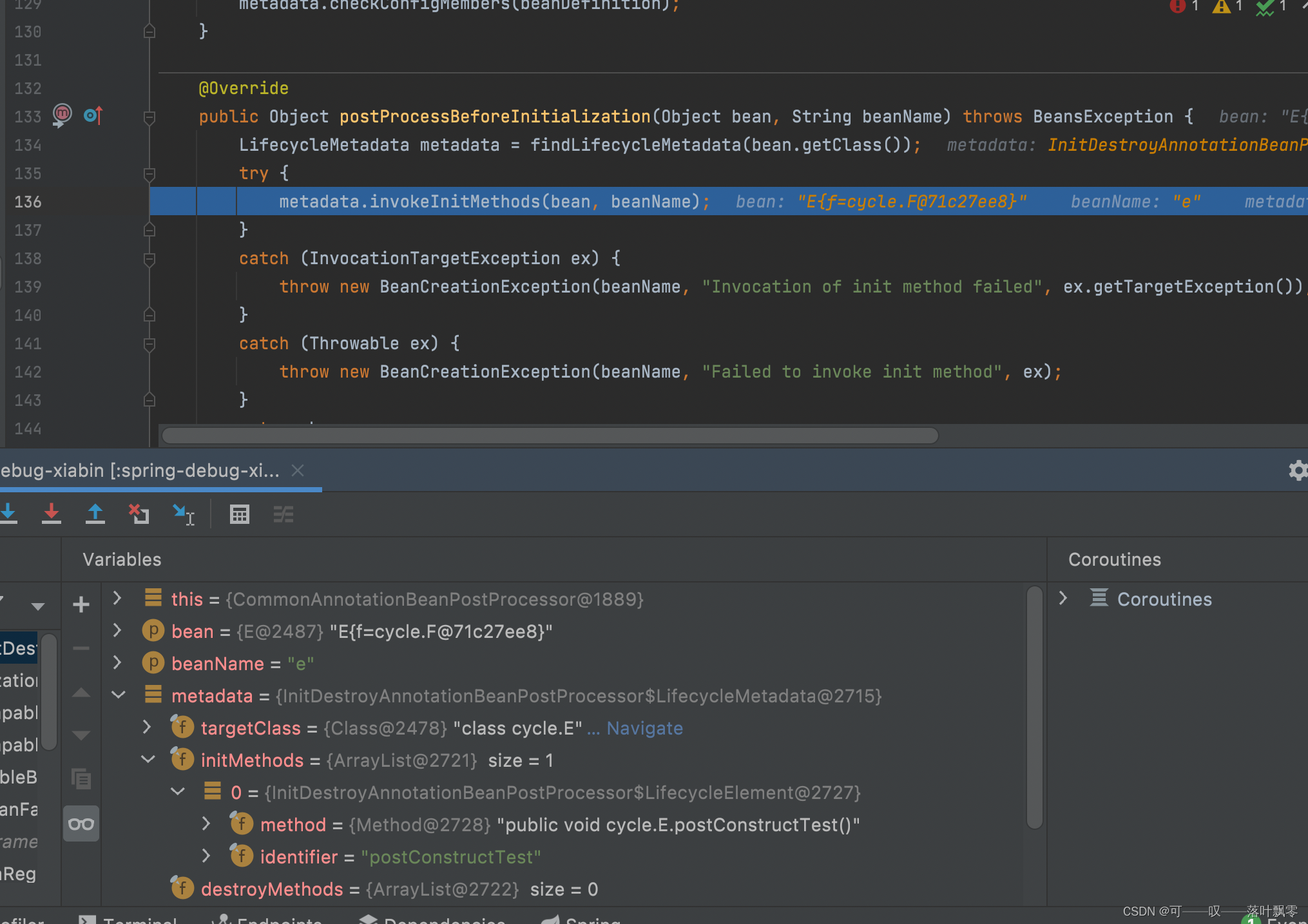
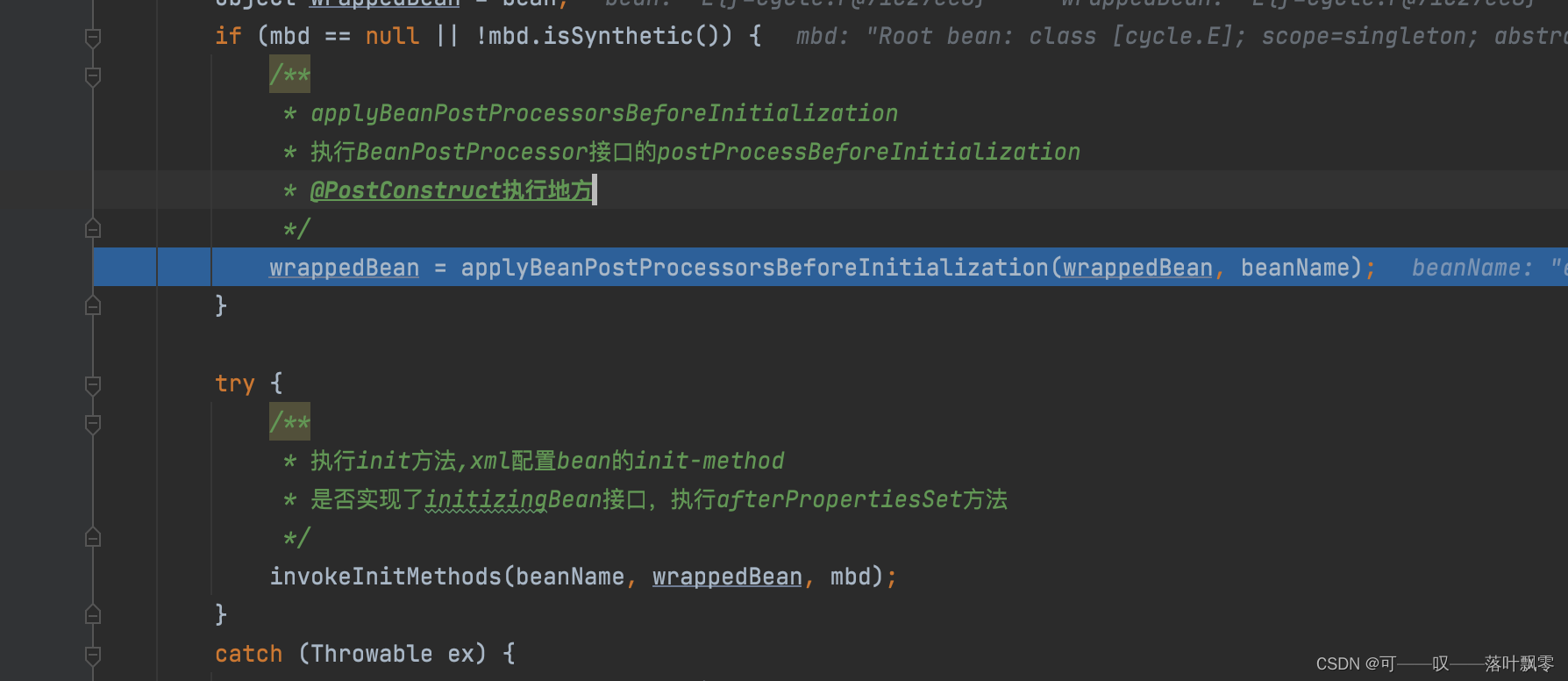
比initizingBean接口的afterPropertiesSet方法先一步
ConfigurationClassPostProcessor扫描装配@Configuration,@ComponentScan,@Component,@Import,@Bean等

ConfigurationClassPostProcessor属于BeanFactoryPostProcessor,BeanFactoryPostProcessor通常用来增强修改BeanDefinition
也是BeanDefinitionRegistryPostProcessor类型,能向spring注册BeanDefinition
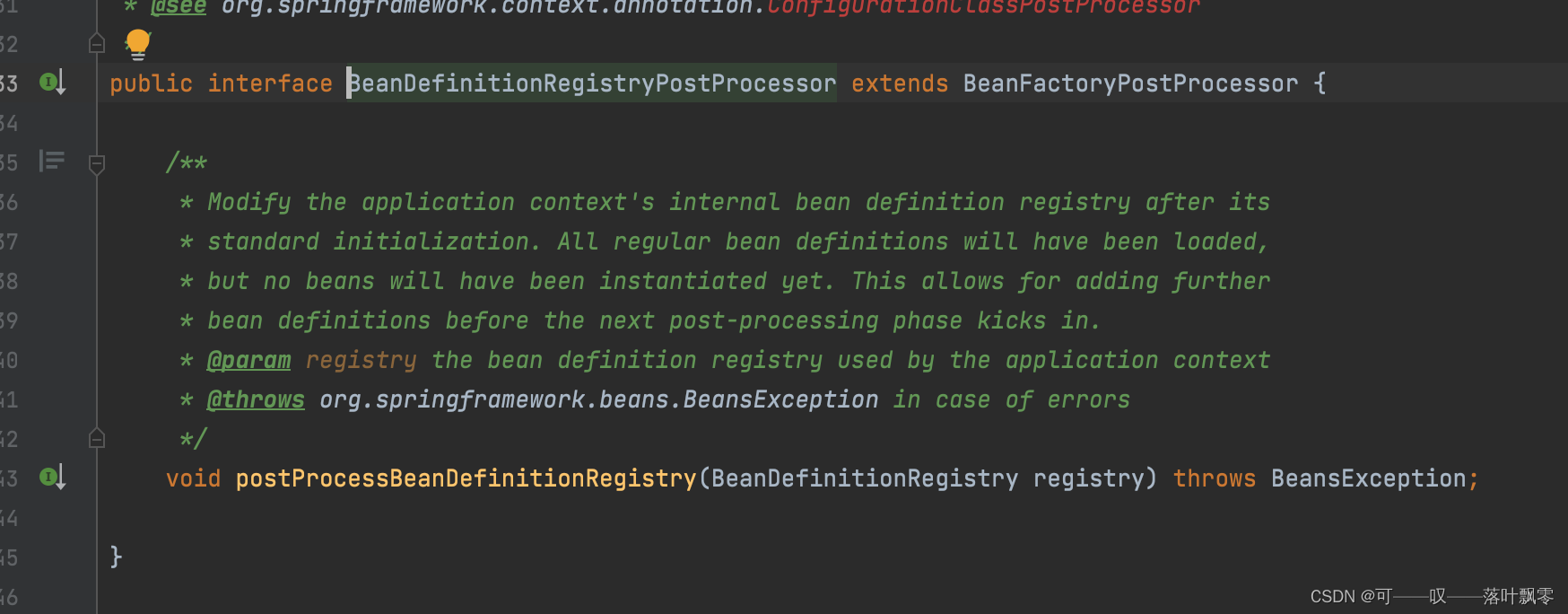
先执行postProcessBeanDefinitionRegistry,然后执行postProcessBeanFactory
入口refresh方法里的invokeBeanFactoryPostProcessors(beanFactory);方法
/**
* 调用执行各种BeanFactoryPostProcessor,里面会调用beanFactory.getBean()找到自定义beanFactoryPostProcessor
* BeanFactoryPostProcessor接口的postProcessBeanFactory方法
* BeanFactoryPostProcessor增强修改BeanDenifition
* springboot自动装配@import
* 扫描注解标注需要加入容器的bean信息到beanDenifition,比如@Componment
*/
invokeBeanFactoryPostProcessors(beanFactory);
然后PostProcessorRegistrationDelegate.invokeBeanFactoryPostProcessors()进去
...省略
for (BeanFactoryPostProcessor postProcessor : beanFactoryPostProcessors) {
// 类型匹配进去
if (postProcessor instanceof BeanDefinitionRegistryPostProcessor) {
BeanDefinitionRegistryPostProcessor registryProcessor =
(BeanDefinitionRegistryPostProcessor) postProcessor;
//首先执行上面的postProcessBeanDefinitionRegistry()
registryProcessor.postProcessBeanDefinitionRegistry(registry);
registryProcessors.add(registryProcessor);
}
else {
regularPostProcessors.add(postProcessor);
}
}
...省略
然后进入ConfigurationClassPostProcessor的processConfigBeanDefinitions(registry);
public void processConfigBeanDefinitions(BeanDefinitionRegistry registry) {
List<BeanDefinitionHolder> configCandidates = new ArrayList<>();
String[] candidateNames = registry.getBeanDefinitionNames();
for (String beanName : candidateNames) {
BeanDefinition beanDef = registry.getBeanDefinition(beanName);
if (ConfigurationClassUtils.isFullConfigurationClass(beanDef) ||
ConfigurationClassUtils.isLiteConfigurationClass(beanDef)) {
if (logger.isDebugEnabled()) {
logger.debug("Bean definition has already been processed as a configuration class: " + beanDef);
}
}
/**
* 判断是否是配置类,如果是@Configuration为BeanDefinition设置属性为ful
* @Bean,@Component,@ComponentScan,@Import,@ImportResource这些注解为lite
*/
else if (ConfigurationClassUtils.checkConfigurationClassCandidate(beanDef, this.metadataReaderFactory)) {
configCandidates.add(new BeanDefinitionHolder(beanDef, beanName));
}
}
// Return immediately if no @Configuration classes were found
if (configCandidates.isEmpty()) {
return;
}
// Sort by previously determined @Order value, if applicable
configCandidates.sort((bd1, bd2) -> {
int i1 = ConfigurationClassUtils.getOrder(bd1.getBeanDefinition());
int i2 = ConfigurationClassUtils.getOrder(bd2.getBeanDefinition());
return Integer.compare(i1, i2);
});
// Detect any custom bean name generation strategy supplied through the enclosing application context
SingletonBeanRegistry sbr = null;
if (registry instanceof SingletonBeanRegistry) {
sbr = (SingletonBeanRegistry) registry;
if (!this.localBeanNameGeneratorSet) {
BeanNameGenerator generator = (BeanNameGenerator) sbr.getSingleton(CONFIGURATION_BEAN_NAME_GENERATOR);
if (generator != null) {
this.componentScanBeanNameGenerator = generator;
this.importBeanNameGenerator = generator;
}
}
}
if (this.environment == null) {
this.environment = new StandardEnvironment();
}
// Parse each @Configuration class
ConfigurationClassParser parser = new ConfigurationClassParser(
this.metadataReaderFactory, this.problemReporter, this.environment,
this.resourceLoader, this.componentScanBeanNameGenerator, registry);
Set<BeanDefinitionHolder> candidates = new LinkedHashSet<>(configCandidates);
Set<ConfigurationClass> alreadyParsed = new HashSet<>(configCandidates.size());
do {
/**
* @Configuration注解以及通过@ComponentScan注解扫描的类加入到BeanDefinitionMap中,其他的
* 的比如这里用到的类《引入的新类》@import等不会直接加入到BeanDefinitionMap中,而是包含所有注解的一起存到parser的configurationClasses属性,
* 后面用到
*/
parser.parse(candidates);
parser.validate();
/**
* 上面parser.parse(candidates)方法解析后的类信息放到了parser.getConfigurationClasses()
*/
Set<ConfigurationClass> configClasses = new LinkedHashSet<>(parser.getConfigurationClasses());
configClasses.removeAll(alreadyParsed);
// Read the model and create bean definitions based on its content
if (this.reader == null) {
this.reader = new ConfigurationClassBeanDefinitionReader(
registry, this.sourceExtractor, this.resourceLoader, this.environment,
this.importBeanNameGenerator, parser.getImportRegistry());
}
/**
* 上面一步parser.parse(candidates)方法实际上加载了一部分BeanDefinition了
* 但是上面用到的类可能用如@Import,@Bean引入其他类,这里进一步解析这些类到BeanDefinition
*/
this.reader.loadBeanDefinitions(configClasses);//加载BeanDefinitions
alreadyParsed.addAll(configClasses);
candidates.clear();
/**
* 上面实际上都解析完成了,这里的判断好像没啥意义
*/
if (registry.getBeanDefinitionCount() > candidateNames.length) {
String[] newCandidateNames = registry.getBeanDefinitionNames();
Set<String> oldCandidateNames = new HashSet<>(Arrays.asList(candidateNames));
Set<String> alreadyParsedClasses = new HashSet<>();
for (ConfigurationClass configurationClass : alreadyParsed) {
alreadyParsedClasses.add(configurationClass.getMetadata().getClassName());
}
for (String candidateName : newCandidateNames) {
if (!oldCandidateNames.contains(candidateName)) {
BeanDefinition bd = registry.getBeanDefinition(candidateName);
if (ConfigurationClassUtils.checkConfigurationClassCandidate(bd, this.metadataReaderFactory) &&
!alreadyParsedClasses.contains(bd.getBeanClassName())) {
candidates.add(new BeanDefinitionHolder(bd, candidateName));
}
}
}
candidateNames = newCandidateNames;
}
}
while (!candidates.isEmpty());
// Register the ImportRegistry as a bean in order to support ImportAware @Configuration classes
if (sbr != null && !sbr.containsSingleton(IMPORT_REGISTRY_BEAN_NAME)) {
sbr.registerSingleton(IMPORT_REGISTRY_BEAN_NAME, parser.getImportRegistry());
}
if (this.metadataReaderFactory instanceof CachingMetadataReaderFactory) {
// Clear cache in externally provided MetadataReaderFactory; this is a no-op
// for a shared cache since it'll be cleared by the ApplicationContext.
((CachingMetadataReaderFactory) this.metadataReaderFactory).clearCache();
}
}
parser.parse(candidates);进去
public void parse(Set<BeanDefinitionHolder> configCandidates) {
for (BeanDefinitionHolder holder : configCandidates) {
BeanDefinition bd = holder.getBeanDefinition();
try {
if (bd instanceof AnnotatedBeanDefinition) {
// 会扫描到@Configuration,@ComponentScan,@Component,@Import引入的所有的需要的类
// 标注注解扫描注册的bean会在这里解析完成放到configurationClasses保存起来,后面会用到
// 进去
parse(((AnnotatedBeanDefinition) bd).getMetadata(), holder.getBeanName());
}
else if (bd instanceof AbstractBeanDefinition && ((AbstractBeanDefinition) bd).hasBeanClass()) {
parse(((AbstractBeanDefinition) bd).getBeanClass(), holder.getBeanName());
}
else {
parse(bd.getBeanClassName(), holder.getBeanName());
}
}
catch (BeanDefinitionStoreException ex) {
throw ex;
}
catch (Throwable ex) {
throw new BeanDefinitionStoreException(
"Failed to parse configuration class [" + bd.getBeanClassName() + "]", ex);
}
}
this.deferredImportSelectorHandler.process();
}
protected void processConfigurationClass(ConfigurationClass configClass) throws IOException {
...省略
// Recursively process the configuration class and its superclass hierarchy.
// 循环所有父类
SourceClass sourceClass = asSourceClass(configClass);
do {
// 核心处理
sourceClass = doProcessConfigurationClass(configClass, sourceClass);
}
while (sourceClass != null);
this.configurationClasses.put(configClass, configClass);
}
protected final SourceClass doProcessConfigurationClass(ConfigurationClass configClass, SourceClass sourceClass)
throws IOException {
if (configClass.getMetadata().isAnnotated(Component.class.getName())) {
// Recursively process any member (nested) classes first
//递归处理内部类
processMemberClasses(configClass, sourceClass);
}
// Process any @PropertySource annotations
for (AnnotationAttributes propertySource : AnnotationConfigUtils.attributesForRepeatable(
sourceClass.getMetadata(), PropertySources.class,
org.springframework.context.annotation.PropertySource.class)) {
if (this.environment instanceof ConfigurableEnvironment) {
processPropertySource(propertySource);
}
else {
logger.info("Ignoring @PropertySource annotation on [" + sourceClass.getMetadata().getClassName() +
"]. Reason: Environment must implement ConfigurableEnvironment");
}
}
// Process any @ComponentScan annotations
/**
*扫描出ComponentScans, ComponentScan注解的所有属性比如basePackages的值
*/
Set<AnnotationAttributes> componentScans = AnnotationConfigUtils.attributesForRepeatable(
sourceClass.getMetadata(), ComponentScans.class, ComponentScan.class);
if (!componentScans.isEmpty() &&
!this.conditionEvaluator.shouldSkip(sourceClass.getMetadata(), ConfigurationPhase.REGISTER_BEAN)) {
for (AnnotationAttributes componentScan : componentScans) {
// The config class is annotated with @ComponentScan -> perform the scan immediately
/**
* 装载basePackages指定的包类到BeanDefinition
*/
Set<BeanDefinitionHolder> scannedBeanDefinitions =
this.componentScanParser.parse(componentScan, sourceClass.getMetadata().getClassName());
// Check the set of scanned definitions for any further config classes and parse recursively if needed
for (BeanDefinitionHolder holder : scannedBeanDefinitions) {
/**
* 子类如果还有ComponentScans,ComponentScan
* 最后再次循环调用checkConfigurationClassCandidate 和 parse方法
*/
BeanDefinition bdCand = holder.getBeanDefinition().getOriginatingBeanDefinition();
if (bdCand == null) {
bdCand = holder.getBeanDefinition();
}
if (ConfigurationClassUtils.checkConfigurationClassCandidate(bdCand, this.metadataReaderFactory)) {
parse(bdCand.getBeanClassName(), holder.getBeanName());
}
}
}
}
/**
* 处理Import注解注册的bean不会放到BeanDefinition,而是configurationClass属性
* springboot用到的的@Import,processImports这个方法会递归调用到自己如果@import的类存在继续引入其他类
*/
// Process any @Import annotations
processImports(configClass, sourceClass, getImports(sourceClass), true);
/**
* 处理处理 @ImportResource解析配置文件的bean
*/
// Process any @ImportResource annotations
AnnotationAttributes importResource =
AnnotationConfigUtils.attributesFor(sourceClass.getMetadata(), ImportResource.class);
if (importResource != null) {
String[] resources = importResource.getStringArray("locations");
Class<? extends BeanDefinitionReader> readerClass = importResource.getClass("reader");
for (String resource : resources) {
String resolvedResource = this.environment.resolveRequiredPlaceholders(resource);
configClass.addImportedResource(resolvedResource, readerClass);
}
}
/**
* 处理 @Bean
*/
// Process individual @Bean methods
Set<MethodMetadata> beanMethods = retrieveBeanMethodMetadata(sourceClass);
for (MethodMetadata methodMetadata : beanMethods) {
configClass.addBeanMethod(new BeanMethod(methodMetadata, configClass));
}
...省略
postProcessBeanFactory方法 CGLIB代理被@Configuration注解标注的类
public void postProcessBeanFactory(ConfigurableListableBeanFactory beanFactory) {
int factoryId = System.identityHashCode(beanFactory);
// 如果还没执行解析工作,则先去执行processConfigBeanDefinitions进行解析
this.factoriesPostProcessed.add(factoryId);
if (!this.registriesPostProcessed.contains(factoryId)) {
processConfigBeanDefinitions((BeanDefinitionRegistry) beanFactory);
}
// 对当前容器中被@Configuration注解标注的BeanDefinition进行CGLIb增强
enhanceConfigurationClasses(beanFactory);
beanFactory.addBeanPostProcessor(new ImportAwareBeanPostProcessor(beanFactory));
}
代理@Configuration注解标注的类是为了保证单例的问题
@Configuration
public class MyConfiguration {
@Bean
public A a() {
return new A();
}
@Bean
public B b() {
a();// 无法保证单例
return new B();
}
}
Springboot自动装配原理
@SpringBootConfiguration
本质就是@Configuration
@EnableAutoConfiguration
@AutoConfigurationPackage
@Import({AutoConfigurationImportSelector.class})
AutoConfigurationImportSelector实现了ImportSelector
会执行到下面的方法
public String[] selectImports(AnnotationMetadata annotationMetadata) {
if (!this.isEnabled(annotationMetadata)) {
return NO_IMPORTS;
} else {
AutoConfigurationMetadata autoConfigurationMetadata = AutoConfigurationMetadataLoader.loadMetadata(this.beanClassLoader);
// 进入里面最后会调用到List<String> configurations = this.getCandidateConfigurations(annotationMetadata, attributes);
AutoConfigurationImportSelector.AutoConfigurationEntry autoConfigurationEntry = this.getAutoConfigurationEntry(autoConfigurationMetadata, annotationMetadata);
return StringUtils.toStringArray(autoConfigurationEntry.getConfigurations());
}
}
里面会调用到
private static Map<String, List<String>> loadSpringFactories(@Nullable ClassLoader classLoader) {
MultiValueMap<String, String> result = (MultiValueMap)cache.get(classLoader);
if (result != null) {
return result;
} else {
try {
//从类路径的META-INF/spring.factories中加载所有默认的自动配置类
//筛选出EnableAutoConfiguration对应的配置类注册为bean
Enumeration<URL> urls = classLoader != null ? classLoader.getResources("META-INF/spring.factories") : ClassLoader.getSystemResources("META-INF/spring.factories");
LinkedMultiValueMap result = new LinkedMultiValueMap();
while(urls.hasMoreElements()) {
URL url = (URL)urls.nextElement();
UrlResource resource = new UrlResource(url);
Properties properties = PropertiesLoaderUtils.loadProperties(resource);
Iterator var6 = properties.entrySet().iterator();
while(var6.hasNext()) {
Entry<?, ?> entry = (Entry)var6.next();
String factoryTypeName = ((String)entry.getKey()).trim();
String[] var9 = StringUtils.commaDelimitedListToStringArray((String)entry.getValue());
int var10 = var9.length;
for(int var11 = 0; var11 < var10; ++var11) {
String factoryImplementationName = var9[var11];
result.add(factoryTypeName, factoryImplementationName.trim());
}
}
}
cache.put(classLoader, result);
return result;
} catch (IOException var13) {
throw new IllegalArgumentException("Unable to load factories from location [META-INF/spring.factories]", var13);
}
}
}
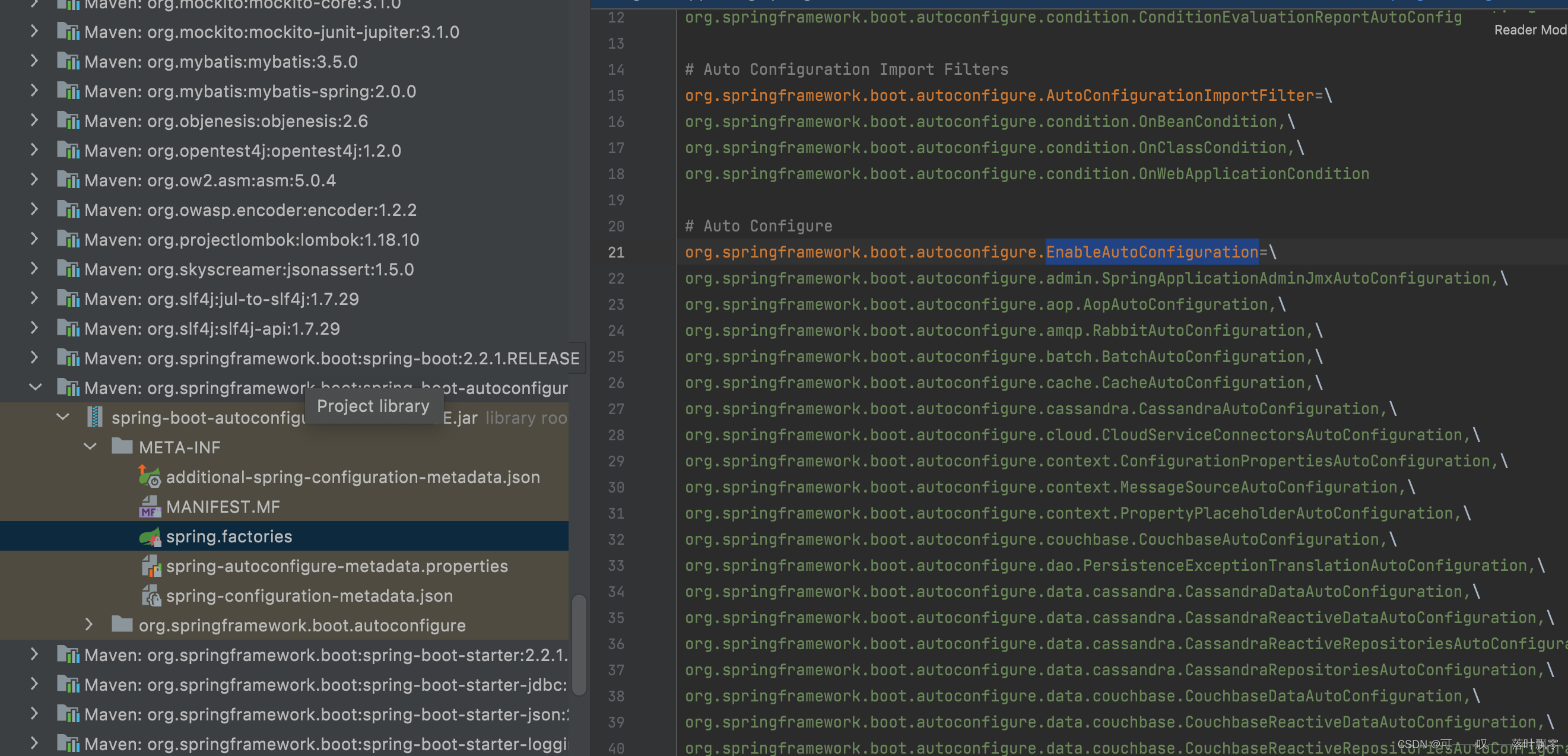
@ComponentScan
查看上面的 ConfigurationClassPostProcessor扫描装配 解析原理
springboot启动自动装配步骤
1、当启动springboot应用程序的时候,会先创建SpringApplication的对象,在对象的构造方法中会进行某些参数的初始化工作,
最主要的是判断当前应用程序的类型以及初始化器和监听器,在这个过程中会加载整个应用程序中的spring.factories文件,将文件的内容放到缓存对象中,方便后续获取。
2、SpringApplication对象创建完成之后,开始执行run方法,来完成整个启动,
启动过程中最主要的有两个方法,第一个叫做prepareContext,第二个叫做refreshContext,在这两个关键步骤中完整了自动装配的核心功能,
前面的处理逻辑包含了上下文对象的创建,banner的打印,异常报告期的准备等各个准备工作,方便后续来进行调用。
3、在prepareContext方法中主要完成的是对上下文对象的初始化操作,包括了属性值的设置,
比如环境对象,在整个过程中有一个非常重要的方法,叫做load,load主要完成一件事,
将当前启动类做为一个beanDefinition注册到registry中,方便后续在进行BeanFactoryPostProcessor调用执行的时候,
找到对应的主类,来完成@SpringBootApplicaiton,@EnableAutoConfiguration等注解的解析工作
4、在refreshContext方法中会进行整个容器刷新过程,会调用中spring中的refresh方法,refresh中有13个非常关键的方法,来完成整个spring应用程序的启动,在自动装配过程中,
会调用invokeBeanFactoryPostProcessor方法,在此方法中主要是对ConfigurationClassPostProcessor类的处理,这次是BFPP的子类也是BDRPP的子类,
在调用的时候会先调用BDRPP中的postProcessBeanDefinitionRegistry方法,
然后调用postProcessBeanFactory方法,在执行postProcesseanDefinitionRegistry的时候回解析处理各种注解,
包含@PropertySource,@ComponentScan,@ComponentScans,@Bean,@Import等注解,最主要的是@Import注解的解析
5、<查看上面的 ConfigurationClassPostProcessor扫描装配 解析原理>
在解析@Import注解的时候,会有一个getimports的方法,从主类开始递归解析注解,把所有包含@Import的注解都解析到,
然后在processlmport方法中对Import的类进行分类,此处主要识别的时候AutoConfigurationImportSelect归属于ImportSelect的子类,
在后续过程中会调用deferredImportSelectorHandler中的process方法,来完整EnableAutoConfiguration的期薪
首先进入run
public static ConfigurableApplicationContext run(Class<?>[] primarySources, String[] args) {
return (new SpringApplication(primarySources)).run(args);
}
//SpringApplication
public SpringApplication(ResourceLoader resourceLoader, Class<?>... primarySources) {
this.sources = new LinkedHashSet();
this.bannerMode = Mode.CONSOLE;
this.logStartupInfo = true;
this.addCommandLineProperties = true;
this.addConversionService = true;
this.headless = true;
this.registerShutdownHook = true;
this.additionalProfiles = new HashSet();
this.isCustomEnvironment = false;
this.lazyInitialization = false;
this.resourceLoader = resourceLoader;
Assert.notNull(primarySources, "PrimarySources must not be null");
this.primarySources = new LinkedHashSet(Arrays.asList(primarySources));
this.webApplicationType = WebApplicationType.deduceFromClasspath();
//设置了initializers和listeners,
//initializers和listeners来源于spring.factories中定义的ApplicationContextInitializer和ApplicationListener
this.setInitializers(this.getSpringFactoriesInstances(ApplicationContextInitializer.class));
this.setListeners(this.getSpringFactoriesInstances(ApplicationListener.class));
this.mainApplicationClass = this.deduceMainApplicationClass();
}
run方法里
public ConfigurableApplicationContext run(String... args) {
StopWatch stopWatch = new StopWatch();
stopWatch.start();
ConfigurableApplicationContext context = null;
Collection<SpringBootExceptionReporter> exceptionReporters = new ArrayList();
this.configureHeadlessProperty();
SpringApplicationRunListeners listeners = this.getRunListeners(args);
listeners.starting();
Collection exceptionReporters;
try {
ApplicationArguments applicationArguments = new DefaultApplicationArguments(args);
ConfigurableEnvironment environment = this.prepareEnvironment(listeners, applicationArguments);
this.configureIgnoreBeanInfo(environment);
//打印springboot图案
Banner printedBanner = this.printBanner(environment);
// 创建上下文默认的服务类型是SERVLET,所以创建的是**”注解配置的Servlet-Web服务容器“,即AnnotationConfigServletWebServerApplicationContext
//创建DeafualtListsbleBeanFactory
//创建this.reader = new AnnotatedBeanDefinitionReader(this);
//创建this.scanner = new ClassPathBeanDefinitionScanner(this);
context = this.createApplicationContext();
exceptionReporters = this.getSpringFactoriesInstances(SpringBootExceptionReporter.class, new Class[]{ConfigurableApplicationContext.class}, context);
//prepareContext方法
//对上下文content设置环境对象
this.prepareContext(context, environment, listeners, applicationArguments, printedBanner);
//refreshContext方法
// 调用到spring的refresh()入口方法
this.refreshContext(context);
this.afterRefresh(context, applicationArguments);
stopWatch.stop();
if (this.logStartupInfo) {
(new StartupInfoLogger(this.mainApplicationClass)).logStarted(this.getApplicationLog(), stopWatch);
}
listeners.started(context);
this.callRunners(context, applicationArguments);
} catch (Throwable var10) {
this.handleRunFailure(context, var10, exceptionReporters, listeners);
throw new IllegalStateException(var10);
}
try {
listeners.running(context);
return context;
} catch (Throwable var9) {
this.handleRunFailure(context, var9, exceptionReporters, (SpringApplicationRunListeners)null);
throw new IllegalStateException(var9);
}
}
常用扩展
1.对 Aware接口扩展获取容器对象
对创建的bean进行操作的时候,如果需要其他对象,可以实现aware接口满足需要
实现想要的Aware接口,重写对应的set方法,这样可以获取想要的其他对象
public class TestAware implements ApplicationContextAware, BeanFactoryAware {
private ApplicationContext applicationContext;
private BeanFactory beanFactory;
public BeanFactory getBeanFactory() {
return beanFactory;
}
private String name;
@Override
public void setApplicationContext(ApplicationContext applicationContext) throws BeansException {
System.out.println("通过aware接口设置applicationContext");
this.applicationContext=applicationContext;
}
public ApplicationContext getApplicationContext() {
return applicationContext;
}
public String getName() {
return name;
}
public void setName(String name) {
this.name = name;
}
@Override
public void setBeanFactory(BeanFactory beanFactory) throws BeansException {
this.beanFactory=beanFactory;
}
public void test(){
Object o=this.beanFactory.getbBean("beanName");
Object o2=this.applicationContext.getbBean("beanName");
}
}
2.全局异常捕获
这样可以放心写自己的业务代码,在这里统一捕获
@RestControllerAdvice
public class GlobalExceptionHandler {
@ExceptionHandler(Exception.class)
public String handleException(Exception e) {
// 判断不同异常进行对应处理
retur null;
}
}
3.自定义拦截器
public class MyInterceptor extends HandlerInterceptorAdapter {
@Override
public boolean preHandle(HttpServletRequest request, HttpServletResponse response, Object handler)
throws Exception {
//业务逻辑
return true;
}
}
注册拦截器
@Configuration
public class MyWebConfig implements WebMvcConfigurer {
@Override
public void addInterceptors(InterceptorRegistry registry) {
registry.addInterceptor(new MyInterceptor());
}
}
4.类型转换器
Converter<S,T>:将 S 类型对象转为 T 类型对象
@Configuration
public class MyWebConfig implements WebMvcConfigurer {
@Override
public void addFormatters(FormatterRegistry registry) {
//Converter将String转化成LocalDateTime
registry.addConverter(new Converter<String, LocalDateTime>() {
@Override
public LocalDateTime convert(String s) {
TemporalAccessor yyyyMMdd = DateTimeFormatter.ofPattern("yyyyMMddHH:mm:ss").parse(s);
return LocalDateTime.from(yyyyMMdd);
}
});
}
}
请求后自动转换
http://127.0.0.1:8080/t/test?localDateTime=2023111112:00:00&t=123
@RequestMapping("/t")
@RestController
public class TestController {
@GetMapping("/test")
public Object test(LocalDateTime localDateTime,String t){
System.out.println(localDateTime);
System.out.println(t);
return localDateTime+t;
}
}
5.导入配置@Import
public class T {
}
被@Import引入的类会被实例化bean对象加入到spring容器
@Import({T.class})
@Configuration
public class MyConfig {
}
其他地方可以直接注入拿来用
@RequestMapping("/t")
@RestController
public class TestController {
@Autowired
private T t;
}
关联性
public class T2 {
}
@Import({T2.class})
public class T {
}
@Import({T.class})
@Configuration
public class MyConfig {
}
具有关联性,把@Import、@ImportResource、@PropertySource等注解引入的类进行递归,一次性全部引入
@Autowired
private T t;
@Autowired
private T2 t2;
结合ImportSelector
实现ImportSelector接口
public class MyImportSelector implements ImportSelector {
@Override
public String[] selectImports(AnnotationMetadata annotationMetadata) {
return new String[]{"com.example.spboottest.config.T3"};
}
}
引入MyImportSelector,一次性引入数组多个类
@Import({T.class,MyImportSelector.class})
@Configuration
public class MyConfig {
}
结合ImportBeanDefinitionRegistrar
实现ImportBeanDefinitionRegistrar接口
写架子的时候方法很多,可以自定义BeanDefinition手动注入到spring容器
// 自己定义BeanDefinition注入到spring容器更灵活
public class MyImportBeanDefinitionRegistrar implements ImportBeanDefinitionRegistrar {
@Override
public void registerBeanDefinitions(AnnotationMetadata importingClassMetadata, BeanDefinitionRegistry registry) {
@Override
public void registerBeanDefinitions(AnnotationMetadata importingClassMetadata, BeanDefinitionRegistry registry) {
BeanDefinitionBuilder beanDefinitionBuilder = BeanDefinitionBuilder.rootBeanDefinition(T4.class);
beanDefinitionBuilder.addPropertyValue("name","张三");
registry.registerBeanDefinition("t4",beanDefinitionBuilder.getBeanDefinition());
}
}
}
//引入T4
@Import({T.class,MyImportSelector.class,MyImportBeanDefinitionRegistrar.class})
@Configuration
public class MyConfig {
}
6.项目启动时
初始化操作,比如加载缓存数据等等
@Component
public class MyApplicationRunner implements ApplicationRunner {
@Override
public void run(ApplicationArguments args) throws Exception {
System.out.println("===============START==============");
}
}
7.BeanFactoryPostProcessor增强修改BeanDefinition
BeanDefinition是用来记录需要实例化的bean的定义信息,可以修改
@Component
public class MyBeanFactoryPostProcessor implements BeanFactoryPostProcessor {
@Override
public void postProcessBeanFactory(ConfigurableListableBeanFactory beanFactory) throws BeansException {
BeanDefinition beanDefinition = beanFactory.getBeanDefinition("a");
// 修改beanDefinition属性,
// beanDefinition.setXXX
System.out.println("设置BeanDefinition:"+beanDefinition);
}
}
8.BeanPostProcessor增强修改Bean
1.createBeanInstance实例化,开辟堆内存空间
2.属性赋值populateBean
3.判断是否实现了Aware接口,容器对象属性设置invokeAwareMethods(到这里实际上对象初始化完成了,下面流程进行增强)
4.调用beanPostProcessor的前置before方法
5.调用初始化方法invokeInitMethods ->判断如果实现InitializingBean就执行afterPropertiesSet,否则直接执行initMethod即可
6.调用beanPostProcessor的后置after方法,创建代理aop对象是这里,
从earlyProxyReferences缓存判断key(getEarlyBeanReference方法放进去的)无循环依赖就走这里创建aop对象,不然走getEarlyBeanReference方法
7.完整对象
在第4和第6步执行
@Component
public class MyBeanPostProcessor implements BeanPostProcessor {
@Override
public Object postProcessBeforeInitialization(Object bean, String beanName) throws BeansException {
System.out.println("我的beanPostProcessor的befor:"+beanName+" "+bean);
// Bean实例化后,可以修改Bean
return BeanPostProcessor.super.postProcessBeforeInitialization(bean, beanName);
}
@Override
public Object postProcessAfterInitialization(Object bean, String beanName) throws BeansException {
System.out.println("我的beanPostProcessor的after:"+beanName+" "+bean);
return BeanPostProcessor.super.postProcessAfterInitialization(bean, beanName);
}
}
9.初始化方法
实现InitializingBean接口或者@PostConstruct
@PostConstruct会比InitializingBean先一步执行
分别是上面的4 和 5 步
@Component
public class InitTest implements InitializingBean {
//第 4 步
@PostConstruct
public void doPostConstruct(){
System.out.println("PostConstruct执行了");
}
//第 5 步
// 让bean创建好后最后给用户一次操作的机会
@Override
public void afterPropertiesSet() throws Exception {
System.out.println("afterPropertiesSet执行了");
}
}
10.DisposableBean销毁
实现DisposableBean接口,并且重写它的destroy方法
@Component
public class MyDisposableBean implements DisposableBean {
@Override
public void destroy() throws Exception {
System.out.println("MyDisposableBean销毁了");
}
}
11.FactoryBean
BeanFactory创建bean要遵循spring完整流程创建
FactoryBean由用户自定义实现,更加灵活
public class MyFactoryBean implements FactoryBean<Person2> {
@Override
public Person2 getObject() throws Exception {
/**
* 自己想怎么创建对象就创建对象,不需要经过标准的处理流程
*/
return new Person2();
}
@Override
public Class<?> getObjectType() {
return Person2.class;
}
}
Person2 person2 = (Person2)ac.getBean("myFactoryBean");
System.out.println(person2);





















 4999
4999











 被折叠的 条评论
为什么被折叠?
被折叠的 条评论
为什么被折叠?










